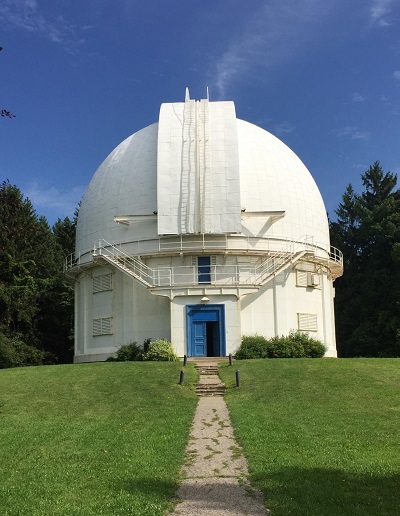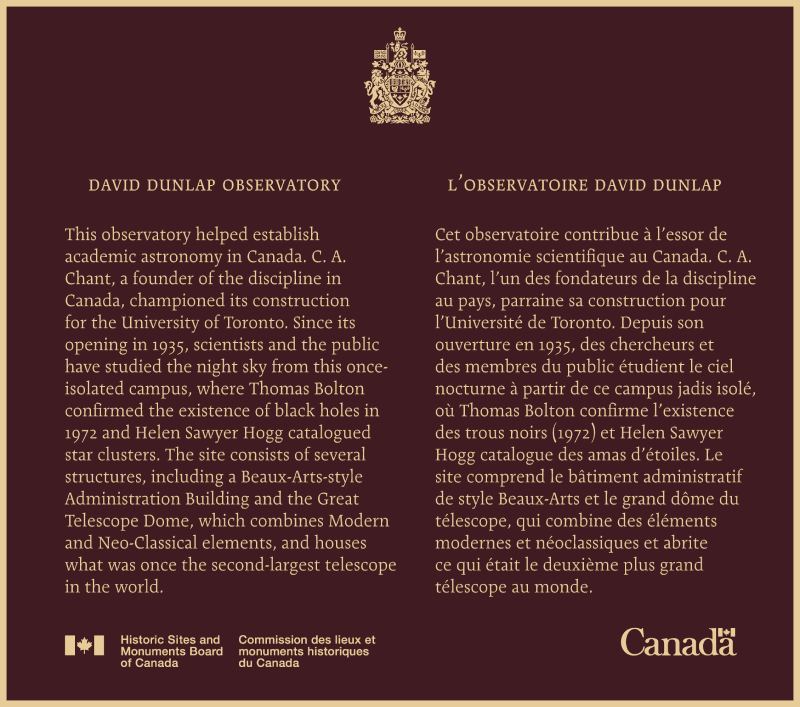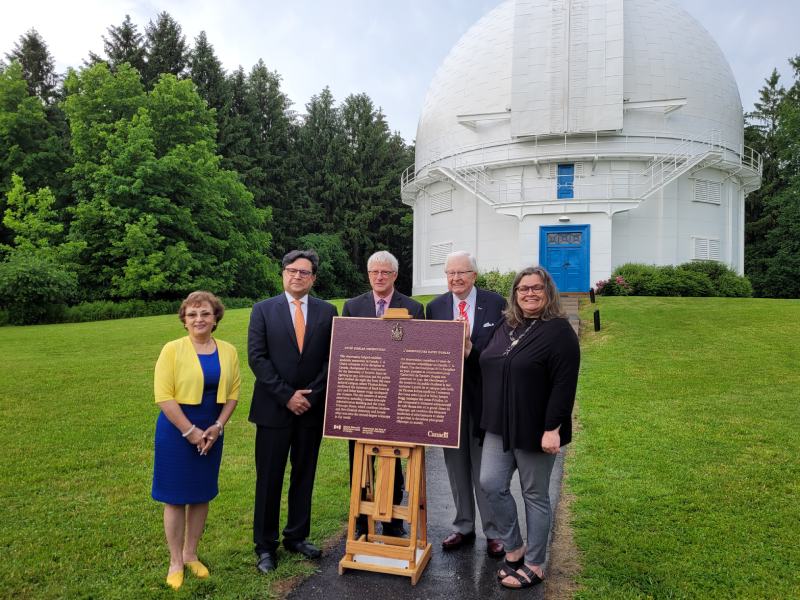David Dunlap Observatory National Historic Site
The David Dunlap Observatory was designated as a national historic site in 2019.
Commemorative plaque: 123 Hillsview Drive, Richmond Hill, OntarioFootnote 1
David Dunlap Observatory
This observatory helped establish academic astronomy in Canada. C. A. Chant, a founder of the discipline in Canada, championed its construction for the University of Toronto. Since its opening in 1935, scientists and the public have studied the night sky from this once-isolated campus, where Thomas Bolton confirmed the existence of black holes in 1972 and Helen Sawyer Hogg catalogued star clusters. The site consists of several structures, including a Beaux-Arts-style Administration Building and the Great Telescope Dome, which combines Modern and Neo-Classical elements, and houses what was once the second-largest telescope in the world.

© Parks Canada / Jennifer A. Cousineau
The David Dunlap Observatory
When it opened in 1935 in what was then an isolated setting in Richmond Hill, Ontario, 20 kilometres north of Toronto, the David Dunlap Observatory (DDO) featured the world’s second-largest telescope at the time and helped establish academic astronomy in Canada. The long-term project of C.A. Chant, a founder of the discipline in Canada, the Observatory was home to generations of astronomers at the University of Toronto, combining a mandate of teaching, research, and public accessibility. Through his research at the DDO, astronomer Thomas Bolton achieved a major astronomical breakthrough when his research confirmed the existence of black holes.

The DDO was financed by Jessie Donalda Dunlap, who named it in memory of her late husband. It comprises two principal buildings. The first is the Great Telescope Dome, a fine and well-preserved example of early to mid-20th century observatory design in Canada that successfully combines Modern and Neo-Classical elements. The second is the Administration building, designed by the architecture firm of Mathers & Haldenby; its elegant Beaux-Arts designs is consistent with their other building designs at the University of Toronto.
As an educational centre, the DDO immediately strengthened the discipline of astronomy in Canada. While the federal government had funded two observatories – the Dominion Observatory in Ottawa and the Dominion Astrophysical Observatory in Victoria – the lack of university facilities meant that there were still no opportunities for Canadian students to receive practical astronomical training during their education. With a world-class observatory, the University of Toronto became the first Canadian school to offer graduate degrees in astronomy, awarding its first doctorate in 1953.
The research conducted at the DDO has informed hundreds of publications, but one stands out as the most significant of these. In the summer of 1971, postdoctoral researcher Thomas Bolton found evidence of a black hole in the middle of the Milky Way. When this was published in 1972, it was a major astronomical development as a black hole had never been identified. The DDO was also the research home of Helen Sawyer Hogg, a renowned expert on star clusters and Canada’s best-known astronomer through the middle of the 20th century.

The DDO’s most striking visual feature is the Great Telescope Dome, often simply called “the observatory.” It is a massive domed structure, the primary function of which is to form a protective envelope for the 74-inch reflecting telescope it houses. It is painted white and comprises a set of raised, retractable shutters for astronomical viewing, characteristic of astronomical architecture throughout the 20th century. Located northeast of the observatory and reached via a paved processional pathway is the Administration Building. Echoing the architecture of the Dome, the Administration Building features three symmetrically disposed domed turrets, each of which once housed a functioning telescope (one of which still does). These smaller domes made the Administration Building a second locus at the site for astronomical research and a place where students could be trained without having to compete with research astronomers for time in the larger dome.
Backgrounder last update: 2022-05-25
The National Program of Historical Commemoration relies on the participation of Canadians in the identification of places, events and persons of national historic significance. Any member of the public can nominate a topic for consideration by the Historic Sites and Monuments Board of Canada.
- Date modified :